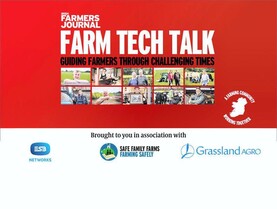Year two financial data, for the Teagasc/Irish Farmers Journal BETTER farm beef challenge participants, is in. It would be fair to say that before pen was even put to paper on completing e-Profit Monitors, the general consensus was that 2018 was an extremely tough year on farm finances.
Whether it was the difficult spring conditions or the long summer drought, each farm was hit one way or another.
As has been continually reported on throughout the last 12 months, conditions took their toll on key areas such as animal performance, herd health and grass growth – all of which chipped away at the bottom line.
Results
Table 1 provides a breakdown of e-Profit Monitor results by system, as well as the group’s overall performance. Jumping straight to gross margin, it is coming in at an average of €610/ha.
Unfortunately, this represents a 13% drop from the group average in 2017. As already mentioned, the signs were pointing towards a gross margin reduction after a turbulent 2018. However, it is the sudden halt in progress that will disappoint the programme farmers the most.
Coming from a base of €570/ha in 2016, 2017 performance showed a year-on-year gross margin increase of 24%.
With so much time and money invested in stock and infrastructure, farmers would have hoped to gather further momentum.
Now over halfway through the programme, it is clearly going to be a big challenge to hit the ambitious €1,250/ha target before the programme’s conclusion, but it is still achievable.
Breakdown
Taking a closer look at performance by system, 20-month bull beef operations returned the highest gross margin in 2018 at €801/ha. Figure 1 shows this was also the system with the largest year-on-year increase, up from €718/ha in 2017.
However, it would be naive not to exercise extreme caution with the 20-month system.
While demand and price for this type of stock was very good in the first half of 2018, the second half of the year and early stages of 2019 have been extremely difficult with price cuts, tight weight restrictions and long slaughter delays being imposed on overage bulls.
These are technically out-of-spec cattle and with that comes high risk.
On the other end of the scale, the figures for weanling producers leave a lot to be desired.
From what was an already low average gross margin of €311/ha in 2017, it has fallen further to €232/ha in 2018. Furthermore, a total of seven weanling producers has now dwindled to just one.
The reality is that the majority of these producers have moved into bull beef production, primarily under 16-month bulls, in pursuit of a higher margin.
But has the conversion worked? The average gross margin for under 16-month bull systems fell €667/ha to €614/ha. The reason for such a drop is largely down to the number of new entrants. In 2017, only five farms operated this system.
A year later, this has more than doubled to 12. As can only be expected, both the performance and efficiency of any first-timer is going to be less than that of the seasoned campaigners.
Those that have been running the under 16-month system for a number of years, fared well.
I think this is best reflected where the range for gross margins among under 16-month bull producers is from as low as €30/ha right up to an impressive €1,563/ha.
The question that must be asked now: is this just a snapshot of a much larger issue? It has been well documented that under 16-month bull beef has very high potential. However, realising this potential is a completely different thing.
With factors such as type of stock, weaning performance, feed quality, housing facilities and even processor relations playing pivotal roles, it is a move that farmers really need to spend time thinking about before any action is taken.
Production
On a positive note, overall farm production is up. The average stocking rate has climbed from 1.97LU/ha to 2.2LU/ha.
Furthermore, looking at Figure 2, average output recorded good growth of 126kg/ha to 859kg/ha.
As a general rule of thumb, top suckler-to-beef farms should be targeting a stocking rate above 2.3LU/ha and output of over 850kg/ha.
For the year, 20-month bull beef production and store selling posted good jumps in output, steer beef and weanling production held steady while under 16-month bull beef had a significant drop, again linked to the aforementioned influx in operators.
The fact that production figures are where they need to be is encouraging.
While neither weather conditions nor beef prices can be controlled by farmers, what’s inside the farm gate most definitely can be.
Going forward for 2019, if the programme farmers can continue to increase productivity, and external factors can facilitate a reduction in variable costs, then the bottom line should be looking a whole lot stronger this time next year.
Of course Brexit is probably the single biggest threat facing the entire beef sector.
Yet despite its threat, there is again very little that farmers can do at this stage only sit, wait and hope for a positive outcome.






 This is a subscriber-only article
This is a subscriber-only article










SHARING OPTIONS: